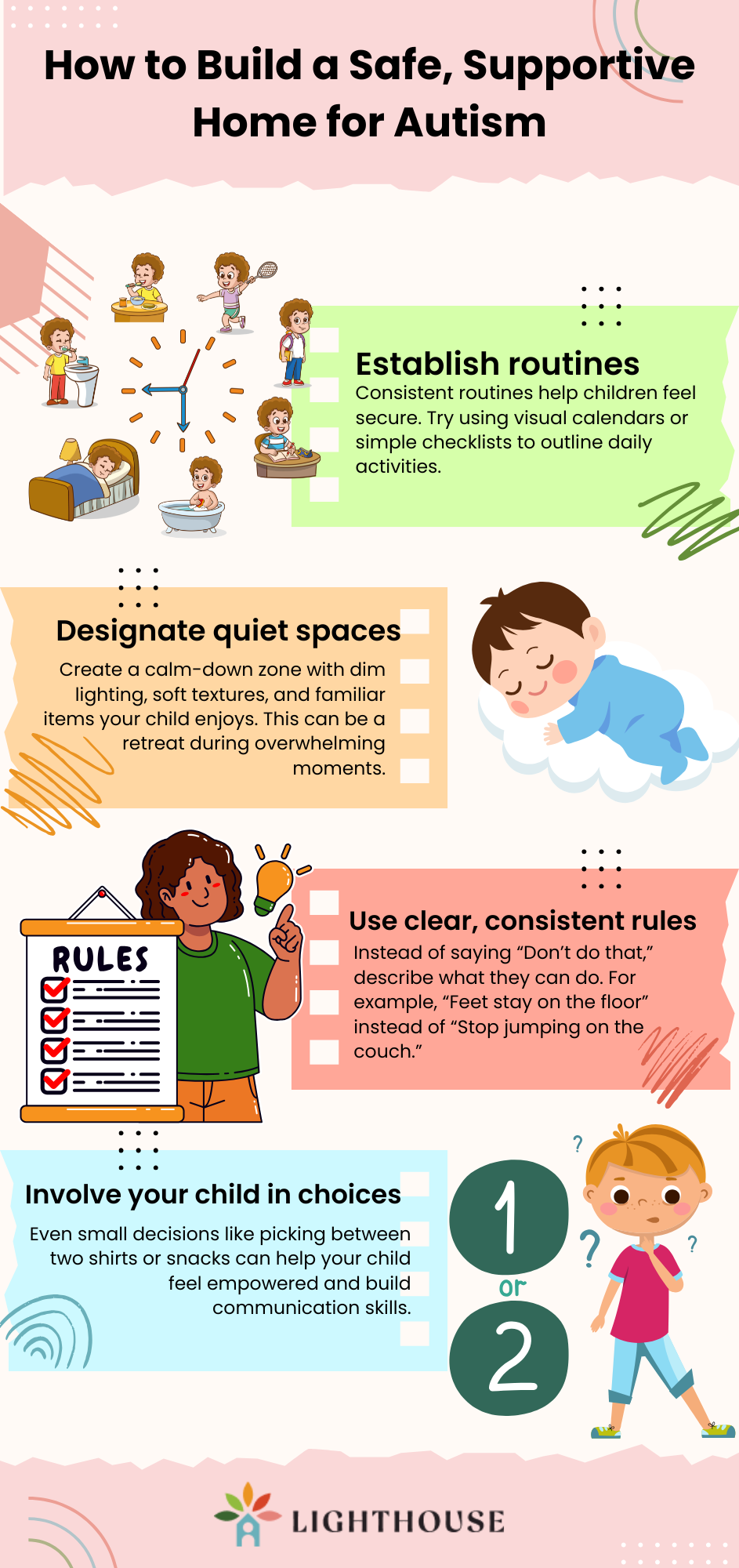Key Points:
- Raising a child with autism requires a balance of advocacy, structure, and emotional connection.
- Effective communication strategies and sensory accommodations can dramatically improve everyday life.
- Parent support systems and ABA therapy can make a meaningful difference in both short- and long-term outcomes.
Raising a child with autism changes the way you think about parenting, often in ways you couldn’t have imagined. You might find yourself tuning in more closely to tiny cues, adjusting your expectations, and learning a whole new language of communication—sometimes literally. The journey is layered. It’s exhausting and enlightening. It can also feel overwhelming, especially when you’re trying to separate the helpful advice from the noise.
Whether your child has just received an autism diagnosis or you’re years into the process, understanding how to meet their unique needs—while also taking care of your own—is essential. This guide aims to walk alongside you, offering practical tools and deeper insight that can help you navigate daily life with confidence and clarity.
 Understanding Autism
Understanding Autism
An autism diagnosis can come with a flood of emotions—relief, confusion, grief, even validation. But it’s important to remember that the label isn’t a verdict; it’s a framework. Autism, or Autism Spectrum Disorder (ASD), is characterized by differences in communication, social interaction, and behavior patterns. That range can be wide, which is why it’s called a spectrum.
Your child may be nonverbal or highly articulate, may love routines or seem indifferent to them, may avoid eye contact or give you the warmest smiles. All of these things can exist under the same diagnostic umbrella. And that’s why raising a child with autism isn’t about applying a one-size-fits-all solution—it’s about tuning into your child’s unique strengths, needs, and interests.
It’s okay not to have all the answers right away. What matters is staying curious, collaborative, and consistent.
Building Communication
When people talk about communication, they usually mean speech. But for many children on the spectrum, communication takes other forms—gestures, visuals, sounds, even behavior itself.
Strategies that support communication development:
- Use visuals consistently. Visual supports—like picture schedules, choice boards, or first-then boards—can help your child process information more easily and predict what comes next. This reduces anxiety and promotes understanding.
- Model language. Whether your child is verbal or nonverbal, narrate what’s happening around them. For example, “You want the truck? Here’s the truck!” builds a connection between words and actions.
- Honor all forms of communication. Pointing, leading you by the hand, or even using a communication device are all valid ways for your child to express themselves. Treat these as meaningful attempts, not lesser forms of communication.
- Pause. Give your child enough wait time to process and respond. Silence can feel awkward, but it’s often when communication finally emerges.
Developing language and social skills takes time. If your child receives ABA therapy or speech therapy, these professionals can offer you tools to reinforce strategies at home.
 Navigating Sensory Differences in Daily Life
Navigating Sensory Differences in Daily Life
One of the most misunderstood aspects of raising a child with autism is how the world feels to them. Bright lights, loud noises, certain textures, or crowded environments can be physically painful or emotionally distressing. On the flip side, some children seek out sensory input—rocking, spinning, touching different textures—because it helps them regulate.
Common sensory challenges and how to support them:
- Auditory sensitivity: Your child may cover their ears or shut down in noisy places. Consider noise-canceling headphones or preparing them in advance with a social story.
- Tactile aversions: Clothing tags, certain foods, or unexpected touches can be uncomfortable. Offer choices when possible, and don’t force your child into sensory experiences they’re not ready for.
- Sensory-seeking behaviors: Jumping, flapping, or chewing may serve a regulatory purpose. You can create safe ways to meet these needs with items like weighted blankets, chewy necklaces, or swings.
Understanding your child’s sensory profile can help prevent meltdowns and make outings more manageable. Occupational therapists trained in sensory integration can also provide tailored support.
How to Build a Safe, Supportive Home for Autism
A predictable, low-stress home environment can be a powerful foundation for children with autism. This doesn’t mean your home has to be silent or sterile—just that your child knows what to expect and feels safe.
Key elements to consider:
Home isn’t just where learning happens—it’s where your child gets to feel most like themselves.
What Parents Need to Know: 5 Essentials That Make a Difference
Once your child receives an autism diagnosis, the path forward may feel like a maze. Here are five essentials that can help guide your decisions and reduce the emotional overload of raising a child with autism.
- Early Intervention Matters
Accessing therapy early—especially evidence-based practices like ABA—can dramatically improve long-term outcomes in communication, social skills, and behavior. Even if your child is older, starting now is still valuable. - You’re Not Alone
Connect with other families, either locally or through online communities. These connections offer emotional validation, shared resources, and practical advice from people who’ve been where you are. - Learn to Read Behavior as Communication
Meltdowns, refusals, or repetitive behaviors aren’t “bad.” They’re often signs of unmet needs. Learning to observe the why behind a behavior helps you intervene more effectively and compassionately. - Self-Care Isn’t Optional
Caregiver burnout is real. Prioritize rest, support, and boundaries. The better you care for yourself, the better you can support your child over the long haul. - Progress Is Not Linear
There will be days of joy, followed by setbacks. Celebrate small wins and avoid comparing your child to others. Growth happens in patterns, not straight lines.
Supporting Siblings and Family Dynamics
When one child has autism, the entire family dynamic shifts. Siblings may feel confused, neglected, or overly responsible. Here’s how you can foster balance and inclusion:
- Be open. Use age-appropriate language to explain autism. Let siblings ask questions and express feelings—even the hard ones.
- Create special time. Set aside regular one-on-one time with each child. It doesn’t have to be elaborate—just consistent.
- Include siblings in small ways. Let them help choose activities or be part of therapy routines if they want to. This can reduce resentment and increase connection.
- Watch for signs of stress. Siblings may mask their emotions to avoid burdening parents. Encourage open dialogue and consider family counseling if needed.
Every family member has a role in shaping a compassionate, resilient home life.
 When and How to Start ABA Therapy
When and How to Start ABA Therapy
Applied Behavior Analysis (ABA) is one of the most widely researched approaches for supporting individuals with autism. But starting therapy can bring up mixed emotions. You may wonder: Is it the right fit? Will my child be understood?
ABA focuses on understanding why behaviors happen and then teaching more functional or socially meaningful alternatives. It’s not about compliance—it’s about building skills that help your child engage more fully with their world.
What to look for in a provider:
- Individualized treatment plans based on your child’s current strengths and needs—not just diagnosis.
- Data-driven progress tracking so you can see what’s working.
- Family involvement to ensure that what’s learned in therapy transfers to home and community settings.
- Compassionate, respectful clinicians who understand your child’s preferences and sensory profile.
Therapy should feel like a collaboration. If something feels off, speak up—your voice matters.
Final Thoughts & Where to Turn for Help
Raising a child with autism comes with questions that don’t always have easy answers. But it also comes with moments of joy, connection, and insight that change you in the best ways. The goal isn’t to “fix” your child—it’s to help them thrive, communicate, and feel understood in a world that doesn’t always adapt easily.
If you’re seeking support that’s structured, responsive, and rooted in evidence-based practices, ABA therapy may be an important next step.
Lighthouse ABA offers personalized, high-quality ABA therapy to help children build meaningful skills at home and beyond. Whether you’re in New York City or North Carolina, our team works closely with families to design interventions that reflect your child’s needs and your values. Learn more about how our therapists and clinical supervisors can support your journey. Contact us today!



